Gamification in education is revolutionizing the way students learn by incorporating game mechanics and elements into the educational experience. This approach aims to make learning more engaging, motivating, and interactive for students. By using educational games and learning through play, gamification transforms the traditional classroom into an adventurous and enjoyable environment, ultimately boosting motivation and academic achievement.
Key Takeaways:
- Gamification in education utilizes game mechanics and elements to make learning more engaging and interactive.
- Educational games and learning through play are key components of gamification in education.
- Gamification in education enhances student motivation, encourages active participation, and promotes academic achievement.
- By incorporating gamified elements, educators can create a more enjoyable and adventurous learning environment.
- Gamification in education is shaping the future of learning and preparing students for success in the ever-changing world.
The Evolution of Gamification in Education
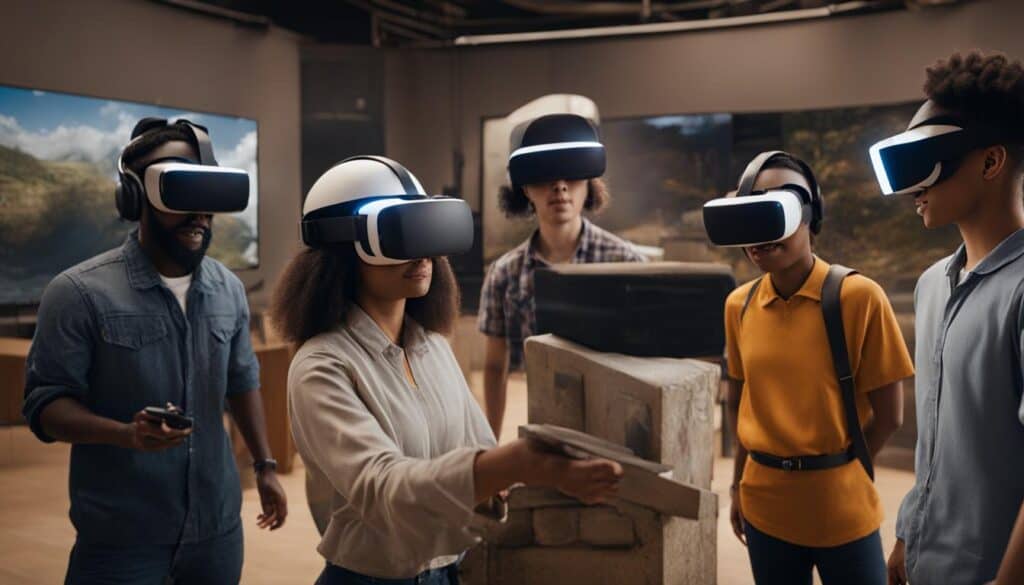
Gamification in education has witnessed a significant evolution over the years. It all began with the incorporation of game mechanics and elements in teaching methods, revolutionizing the traditional classroom experience. Educators started utilizing rewards, levels, and challenges to motivate and incentivize students, making learning more engaging and interactive.
Today, there are numerous examples of gamification in education that showcase its effectiveness in enhancing student engagement and improving learning outcomes. Educational apps, with their gamified interfaces and interactive features, have become popular tools for teachers to engage students in various subjects. Virtual reality simulations offer immersive experiences that enable students to explore new environments and gain practical knowledge. Online platforms gamify learning activities, turning homework and quizzes into interactive challenges that promote active participation.
Gamification in education has proven to be a powerful tool for fostering student engagement and motivation. By tapping into the inherent enjoyment and sense of achievement associated with games, educators have successfully captured students’ attention and created a more conducive learning environment. As the field of education continues to embrace innovative teaching methods, gamification stands out as a dynamic approach that can transform traditional classrooms into exciting learning landscapes.
Advantages of Gamification in Education
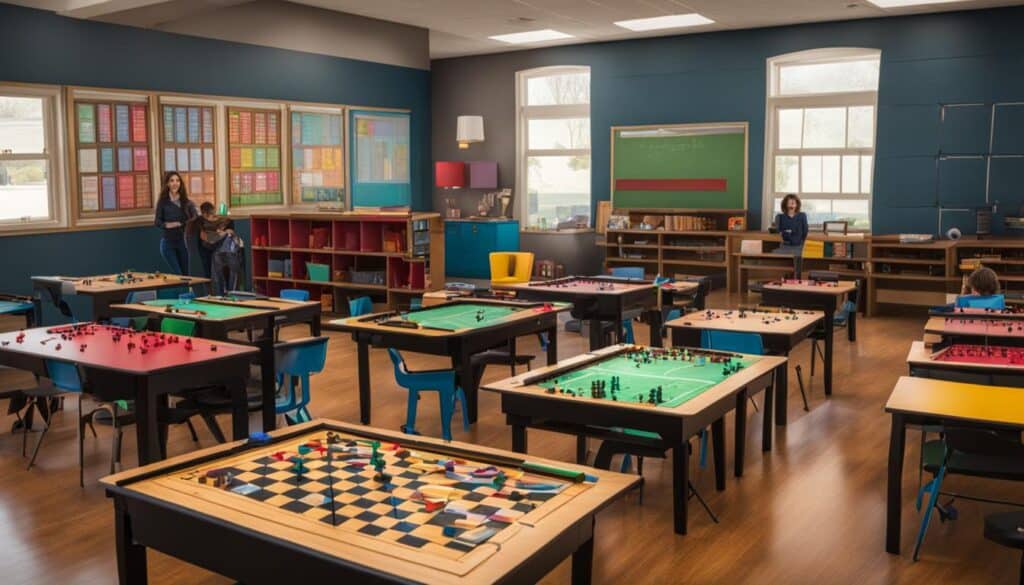
Gamification in education offers several advantages that enhance the learning experience for students. By incorporating elements of games, such as rewards, achievements, and competition, gamification boosts student motivation and engagement. Students are more likely to actively participate and remain focused on their studies when they are immersed in a gamified learning environment.
Gamification also promotes the development of critical skills such as problem-solving, critical thinking, and collaboration. Through gamified learning experiences, students are encouraged to think creatively, analyze information, and work together with their peers to overcome challenges. In this dynamic and immersive learning environment, students take ownership of their education, becoming active participants rather than passive recipients of knowledge.
Gamification in education provides a platform for students to apply their knowledge and skills in a practical context. By integrating gaming elements into the learning process, students can see the direct application of their learning and experience the real-world relevance of their studies.
In summary, gamification in education offers advantages that go beyond traditional teaching methods. By harnessing the power of games and incorporating them into the classroom, educators can create a more engaging, interactive, and effective learning environment.
Gamification in Practice
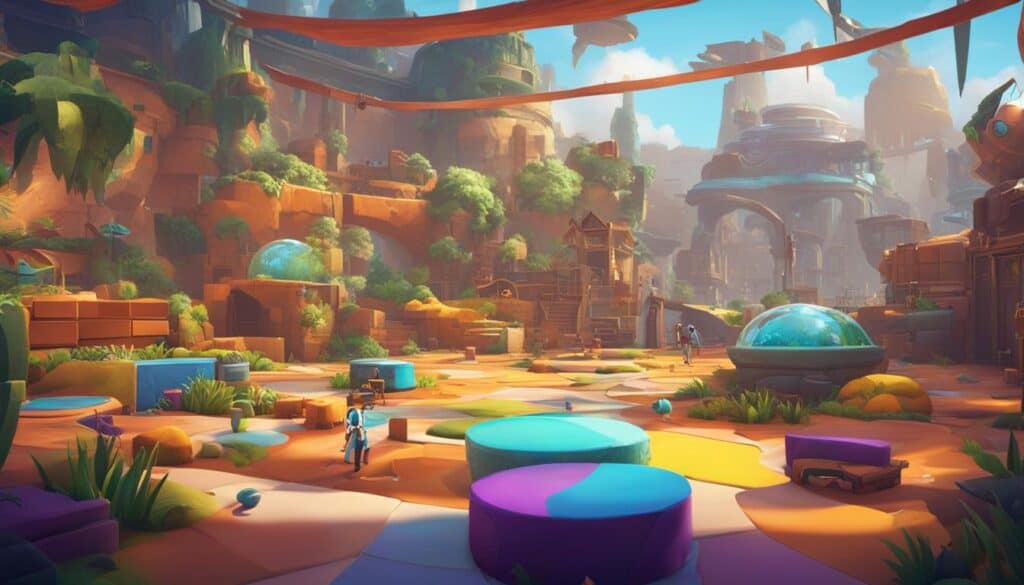
Gamification in education is brought to life through the development and implementation of educational games. These games are carefully designed to provide students with an interactive and hands-on learning experience. By blending educational content with game mechanics, students can learn new concepts and skills while thoroughly enjoying themselves. Educational games span a range of formats, from simple online quizzes to immersive virtual reality simulations, catering to a variety of age groups and subjects.
Through play, students actively engage with the learning material and retain knowledge more effectively. Educational games offer a dynamic and captivating approach to education, allowing students to explore, experiment, and learn at their own pace. By transforming educational content into an enjoyable and game-like experience, students are motivated to participate and actively seek out new learning opportunities.
“Educational games provide students with a unique opportunity to learn and have fun simultaneously. By leveraging the power of play, educators can capture students’ attention and foster a love for learning that goes beyond traditional methods.” – Dr. Sarah Johnson, Education Specialist
Educational games for children are designed to engage young learners through interactive gameplay and captivating visuals. These games incorporate educational elements into captivating storylines and characters, making learning a joyful exploration. By encouraging children to learn through playing, these games promote critical thinking, problem-solving, and creativity in an entertaining and immersive manner. From math challenges to language puzzles, educational games for children offer a wide range of engaging activities that support their educational development.
Whether it’s solving complex puzzles, exploring historical landmarks, or conducting virtual experiments, the potential of educational games is astounding. Through gamification, students are empowered to expand their knowledge, spark their curiosity, and discover the joy of learning. Educational games present a powerful tool that educators can incorporate into their teaching strategies to create engaging and impactful learning experiences for students of all ages.
Innovative Teaching Approaches with Gamification
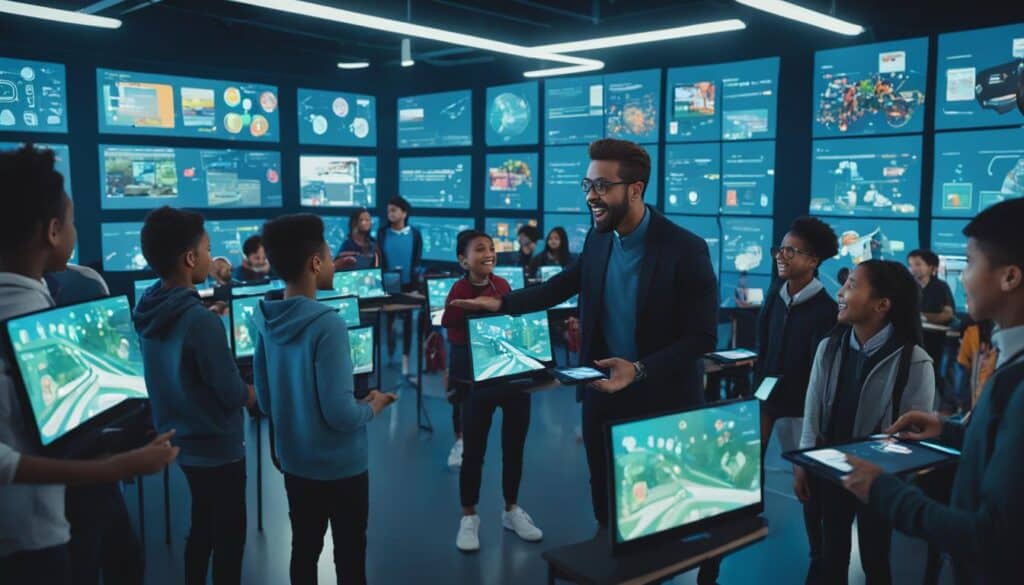
Gamification in education brings forth a multitude of possibilities for innovative teaching approaches. By integrating gamified learning techniques, such as quests, puzzles, and interactive activities, teachers can transform traditional lessons into engaging and impactful experiences. These techniques foster active learning, encourage student participation, and enhance problem-solving skills.
One effective gamified learning technique is the use of quests, where students embark on exciting virtual adventures to complete educational tasks and challenges. By incorporating storytelling elements and game mechanics, quests turn learning into a thrilling journey, motivating students to actively engage with the subject matter.
“Gamification has revolutionized my teaching approach. By incorporating interactive quests into my history lessons, my students are not only learning about the past, but they are also developing critical thinking skills and collaboration abilities in an enjoyable and immersive way.” – Sarah Johnson, History Teacher
Puzzles are another gamified learning technique that can captivate students’ attention and enhance their cognitive abilities. Whether it’s solving math equations, deciphering codes, or unraveling mysteries, puzzles encourage logical thinking, problem-solving, and analytical skills.
Interactive activities are also highly effective in creating an engaging classroom environment. By incorporating hands-on experiments, simulations, and group projects, interactive teaching methods promote student involvement and collaboration. These activities provide opportunities for students to apply their knowledge in real-world scenarios, fostering a deeper understanding of the subject matter.
Technology plays a significant role in gamified teaching, offering a range of interactive tools and platforms. Augmented reality (AR) enables students to explore virtual objects in the real world, bringing abstract concepts to life. Gamified apps provide interactive learning experiences, allowing students to access educational content while engaging in gameplay.
By embracing these innovative teaching approaches, educators can create a dynamic and stimulating learning environment, enabling students to develop essential skills while enjoying the educational journey.
Gamification Strategies and Policies

Implementing gamification in education requires careful planning and consideration of strategies and policies. Educators must determine how to effectively incorporate gamified elements into the curriculum and set clear learning objectives. By integrating gamification in classroom teaching, educators can create a more interactive and engaging learning environment for students.
One of the key aspects of implementing gamification in education is ensuring that the technology and resources required for interactive learning games are accessible to all students. This includes providing devices, software, and internet access that enable students to fully participate in gamified activities. It is important to consider the availability and affordability of these resources to ensure equitable access for every student.
Gamification strategies should align with the educational goals of the curriculum. Educators must identify the specific learning outcomes they aim to achieve through gamification and design interactive learning games that reinforce those objectives. This may involve creating a progression system with levels and rewards, incorporating game elements that encourage problem-solving and critical thinking, or developing collaborative activities that promote teamwork and communication.
While implementing gamification, it is essential to address policies that ensure a fair and inclusive gamified learning environment. This includes issues such as data privacy, digital citizenship, and fairness in the gamified system. Policies should outline guidelines for the collection and use of student data, encourage responsible digital behavior, and ensure that the gamified system does not create disadvantages or discrimination among students.
Effective implementation of gamification in education requires a balance between engaging students through interactive learning games and maintaining a fair and inclusive learning environment.
In conclusion, gamification in education requires educators to develop sound strategies and policies that align with the curriculum’s educational goals. By integrating gamification in classroom teaching, students can enjoy interactive learning games that enhance their motivation and engagement. However, it is important to prioritize accessibility, fair policies, and effective use of technology to ensure the success of gamified learning experiences.
The Future of Gamification in Education
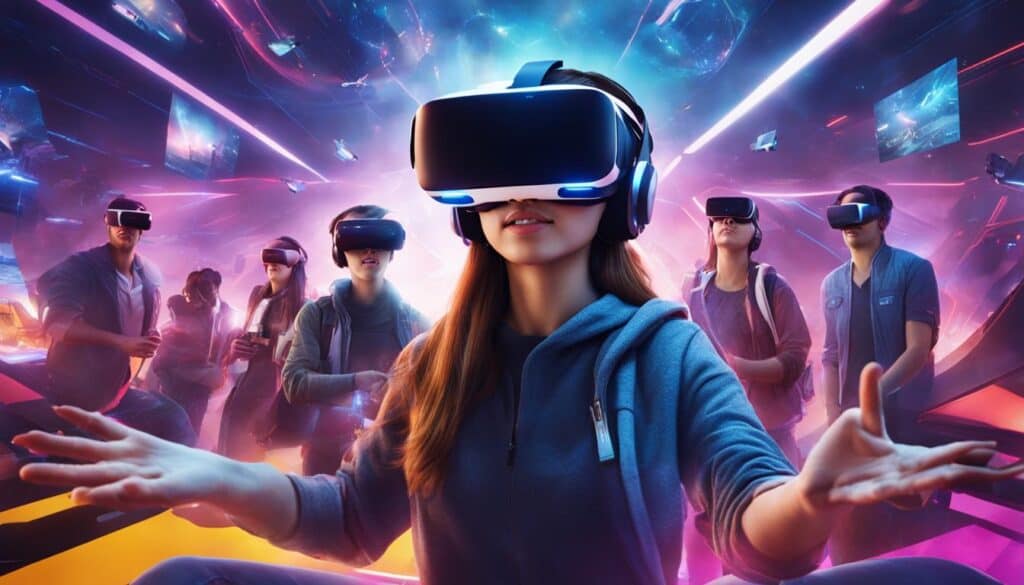
The future of gamification in education holds tremendous potential as technology continues to advance. With the increasing prevalence of digital platforms and immersive technologies, such as virtual reality and augmented reality, gamification is poised to revolutionize the way students learn.
One of the key areas where gamification is expected to make a significant impact is in personalized learning. By incorporating game elements into adaptive learning algorithms, educators can create individualized learning experiences that cater to each student’s unique needs and preferences. This tailored approach fosters greater engagement and enhances learning outcomes.
Artificial intelligence (AI) will also play a pivotal role in the future of gamification in education. AI-powered systems can analyze student data to provide personalized feedback, recommendations, and interventions. These intelligent platforms have the potential to transform the education landscape by providing real-time support and guidance to students.
In addition, competency-based education will benefit greatly from gamification. Gamified learning experiences can provide students with opportunities to demonstrate their mastery of specific skills and competencies. By earning badges, leveling up, and completing challenges, students can showcase their abilities in a motivating and interactive way.
The integration of gamification into education extends beyond traditional classrooms. It can be seamlessly incorporated into online courses, distance learning programs, and virtual learning environments. For example, virtual reality simulations can transport students to historical eras, outer space, or scientific laboratories, providing immersive and experiential learning opportunities.
As the future unfolds, gamification in education will continue to evolve, representing a powerful tool for enhancing student engagement, motivation, and learning outcomes. By leveraging the potential of digital technologies and innovative teaching methodologies, educators can unlock the full benefits of gamification in education.
Realizing the Potential of Gamification

Gamification in education has the power to revolutionize learning, but realizing its full potential requires addressing various challenges and barriers. Here are some key factors that need to be considered to create a supportive ecosystem for gamification in education:
Equal Access to Technology and Resources
Ensuring that all students have equal access to technology and resources is crucial for successful implementation of gamified learning experiences. This includes providing access to devices, internet connectivity, and educational platforms that support gamification.
Teacher Training in Gamification Strategies
Teachers play a critical role in implementing gamification in education. Providing them with proper training and support in gamification strategies will enable them to effectively integrate game mechanics and elements into their teaching practices.
Evaluating Effectiveness of Gamified Learning Experiences
Evaluation is essential to determine the effectiveness of gamified learning experiences. Collecting data and feedback from students, assessing learning outcomes, and continuously improving the gamification approach are essential steps to ensure its success.
Development of High-Quality Educational Games
The development of high-quality educational games that align with curriculum standards and learning objectives is crucial for the success of gamification in education. These games should be engaging, interactive, and designed to promote specific educational outcomes.
Collaboration Between Educators, Game Developers, and Policymakers
Collaboration is vital to create a supportive ecosystem for gamification in education. Educators, game developers, and policymakers need to work together to exchange knowledge, share best practices, and establish guidelines that promote effective gamification strategies in educational settings.
By addressing these challenges and barriers, we can unlock the full potential of gamification in education and create an engaging and impactful learning experience for students.
Gamification in Education – A Global Perspective
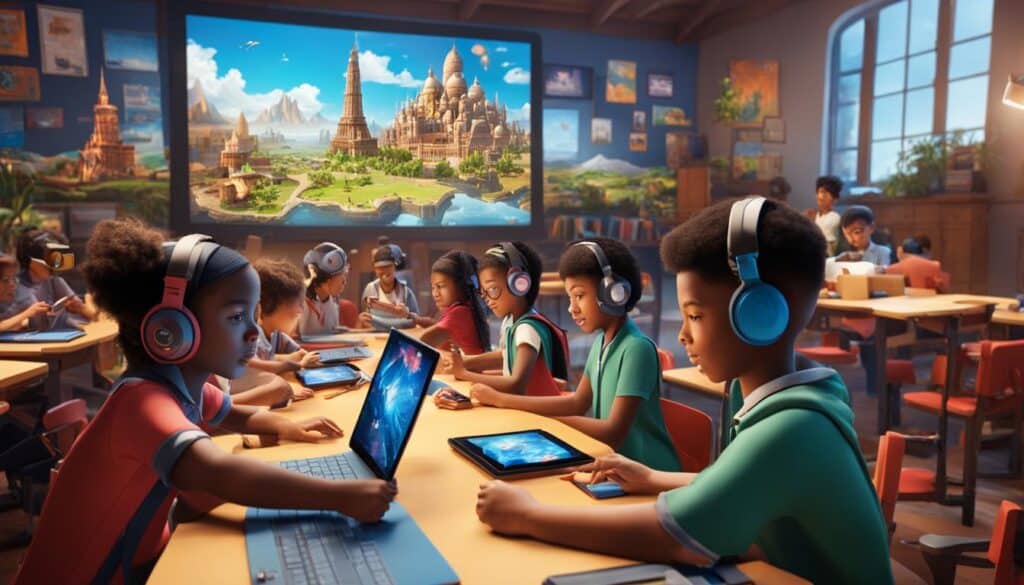
Gamification in education has transcended geographical boundaries and is making a significant impact worldwide. Schools and educational institutions across the globe are embracing the power of gamified teaching methods to enhance learning experiences. This international adoption of gamification showcases its potential to improve learning outcomes and engage students from diverse cultures and educational systems.
From North America to Europe, Asia to Africa, examples of gamification in education can be found everywhere. Schools in the United States have integrated gamified learning platforms into their curricula, while European institutions have incorporated educational games to reinforce learning objectives. In countries like Japan, virtual reality simulations are being used to create immersive and interactive learning experiences.
Incorporating gamification in education on an international scale not only enhances students’ academic performance but also promotes cross-cultural understanding and collaboration.
By embracing gamification, educators are not only creating engaging learning environments but also fostering global connections among students. Through gamified educational experiences, students gain exposure to different cultures, perspectives, and ways of learning, fostering empathy and understanding.
The global impact of gamification in education extends beyond the classroom. With technology breaking down barriers, educational game developers and platforms have the ability to reach students in remote areas or regions with limited educational resources. This inclusivity allows students from all corners of the world to access quality education and benefit from gamified learning experiences.
As gamification continues its global surge in the field of education, it reinforces the notion that learning is a universal experience. The effectiveness of gamified teaching methods transcends borders, empowering students worldwide to embrace learning in a fun, interactive, and meaningful way.
The Role of Gamification in Skill Building

Gamification in education plays a crucial role in skill building. By incorporating game-based learning methods, students can develop a wide range of skills, including problem-solving, critical thinking, collaboration, creativity, and digital literacy.
Gamification provides a platform for students to practice and apply these skills in a fun and interactive way, preparing them for success in the future workforce. As students engage in skill-building gamification activities, they are not only learning the subject matter but also developing essential competencies that are highly valued in today’s rapidly evolving world.
- Problem-Solving: Gamified learning environments present students with challenges and puzzles that require critical thinking and problem-solving skills to overcome. By actively engaging with problems presented in a game format, students learn how to analyze, strategize, and find innovative solutions.
- Critical Thinking: Through game-based learning methods, students are encouraged to think critically, evaluate information, and make informed decisions within the context of the game. This helps develop their ability to think independently, consider multiple perspectives, and apply logic and reasoning.
- Collaboration: Many gamification strategies promote collaborative learning experiences, allowing students to work together to achieve common goals. Through teamwork and cooperation, students develop vital interpersonal and communication skills necessary for success in various professional settings.
- Creativity: Gamified learning activities often require students to think creatively and come up with innovative solutions. By encouraging out-of-the-box thinking and rewarding creativity, gamification fosters students’ imagination and inspires them to explore new ideas and approaches.
- Digital Literacy: In today’s digital age, proficiency in using technology is essential. Gamification provides an opportunity for students to develop and enhance their digital literacy skills. Whether it’s navigating through virtual environments, using educational software, or collaborating online, students gain valuable experience in utilizing technology effectively.
Gamification in education transforms the learning experience by immersing students in interactive and engaging gameplay scenarios where they can apply and reinforce these essential skills. The integration of game-based learning methods not only enhances subject knowledge but also equips students with the skills necessary to thrive in their personal and professional lives.
By harnessing the power of gamification, educators can tap into students’ natural inclination for play and create an environment that fosters skill development, motivation, and active learning. Through the exciting blend of education and entertainment, skill-building gamification paves the way for a more dynamic and effective approach to education.
Case Studies in Gamification
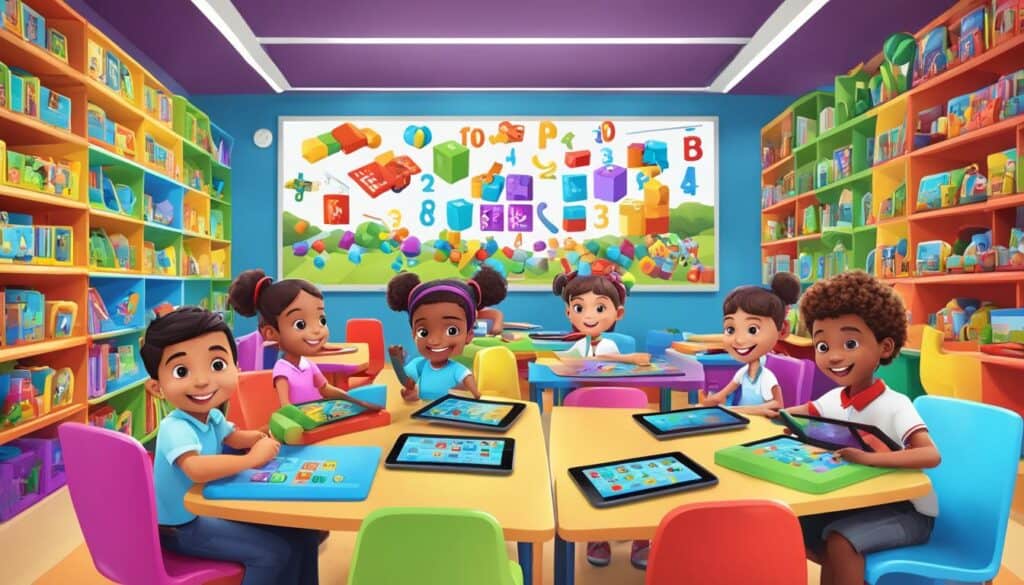
Numerous case studies serve as compelling examples of the successful implementation of gamification in education. These case studies highlight the positive impact that educational games and gamified teaching methods have on student engagement, motivation, and learning outcomes.
One notable case study involves the use of educational games for children to teach math concepts. By integrating game mechanics and playful elements into math activities, students are more actively engaged in the learning process. The use of interactive visuals, game-based challenges, and rewards makes learning math enjoyable and accessible to young learners.
Another example is the integration of virtual simulations in science education. Students can immerse themselves in virtual environments to conduct experiments, explore scientific concepts, and solve complex problems. The interactive nature of these simulations fosters curiosity and critical thinking, allowing students to develop a deeper understanding of scientific principles.
“Gamified learning experiences encourage students to take ownership of their education, resulting in increased motivation and academic achievement. By transforming the learning environment into an enjoyable and interactive space, gamification brings a dynamic and personalized approach to education.”
Moreover, case studies have demonstrated the effectiveness of gamification in language learning. Through the use of interactive language games, students can practice vocabulary, grammar, and pronunciation in a fun and engaging way. Gamified language learning platforms provide immediate feedback, adaptive challenges, and progress tracking, allowing students to monitor their improvement and stay motivated.
The power of gamification in education is further exemplified by the success of online platforms that offer a wide range of gamified learning activities across various subjects. These platforms provide an extensive library of educational games for children, catering to different learning styles and abilities. By incorporating elements of competition, rewards, and achievements, these platforms foster healthy competition, collaboration, and a love for learning.
These case studies serve as compelling evidence of how gamification can transform the learning experience and make education more enjoyable and effective. By leveraging the power of educational games and gamified teaching methods, educators can create a dynamic and engaging learning environment that motivates students to actively participate and achieve academic success.
Gamification and the Changing Landscape of Education
Gamification is reshaping the landscape of education, offering new possibilities for teaching and learning. With the incorporation of game mechanics and elements, education is becoming more student-centered and personalized. Gamification enhances accessibility, engagement, and relevance in the educational experience. As technology continues to advance and new innovations emerge, the role of gamification in education will continue to grow.
By infusing game-based approaches into the learning process, students are motivated and incentivized to actively participate. Gamification creates an immersive and interactive environment that captures students’ attention and makes learning enjoyable. It fosters critical thinking, problem-solving skills, and collaboration among students.
As we embrace the future of education, gamification plays a crucial role in preparing students for the ever-changing world. It equips them with the skills and competencies needed to thrive in a digital age. Through gamification, the learning experience becomes more dynamic, adaptable, and engaging.
Technology advancements such as virtual reality, augmented reality, and artificial intelligence will further enhance gamification in education. These innovations provide opportunities for immersive learning experiences and personalized education. Gamification enables students to explore and learn at their own pace, gaining practical skills in a fun and interactive manner.
Gamification in education transforms the traditional classroom into a vibrant and interactive space. It empowers students to take ownership of their learning journey and cultivates a love for knowledge. With the changing landscape of education, gamification offers immense potential to revolutionize the way students learn and thrive in the future.
Conclusion:
Gamification in education is a game-changer that has the potential to revolutionize the learning experience. By incorporating game mechanics and elements into the curriculum, educators can create an innovative and interactive environment that engages students and enhances their learning journey. Through gamification, students become active participants in their education, motivated by challenges, rewards, and a sense of achievement.
Incorporating gamification in education fosters critical thinking, problem-solving skills, and collaboration. Students are encouraged to think creatively, make informed decisions, and work together to overcome obstacles. The interactive nature of gamified learning keeps students engaged and motivated to explore and acquire new knowledge.
The future of education lies in embracing gamification, technology, and innovative teaching methods. By leveraging gamified learning experiences, educators can tap into the full potential of students, preparing them for a rapidly evolving world. Through gamification, we can make education more exciting, interactive, and relevant, unlocking endless possibilities for student success.
 Fullersears
Fullersears





